
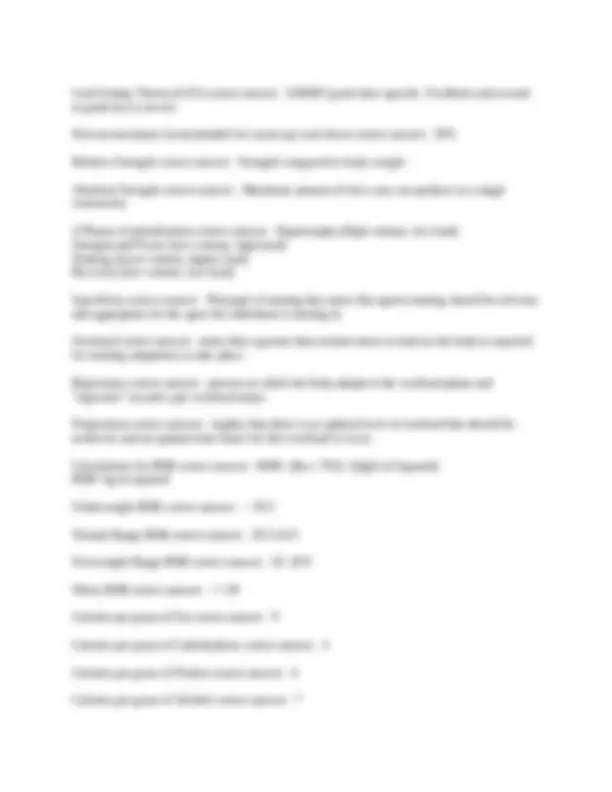
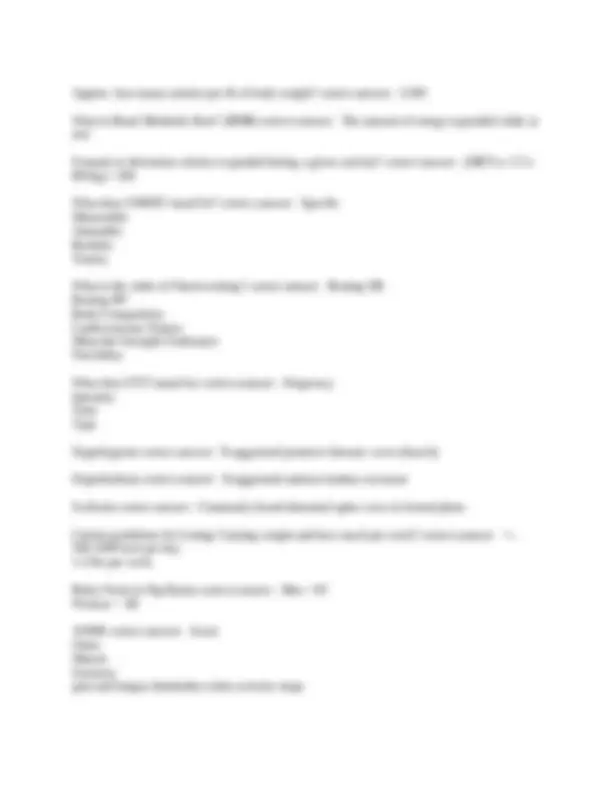
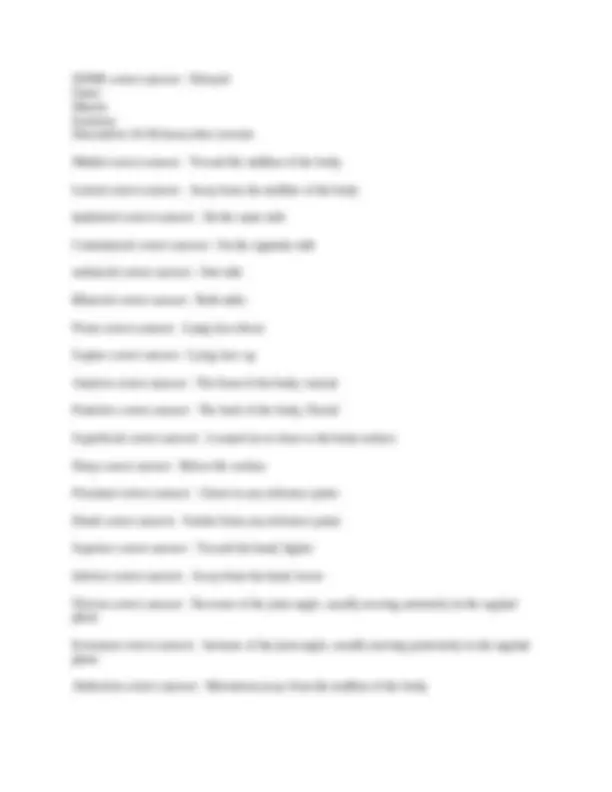
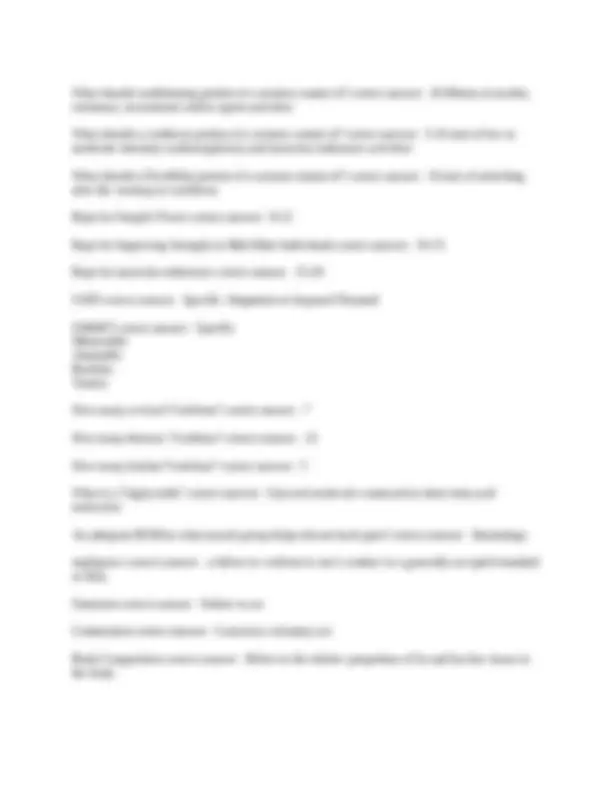
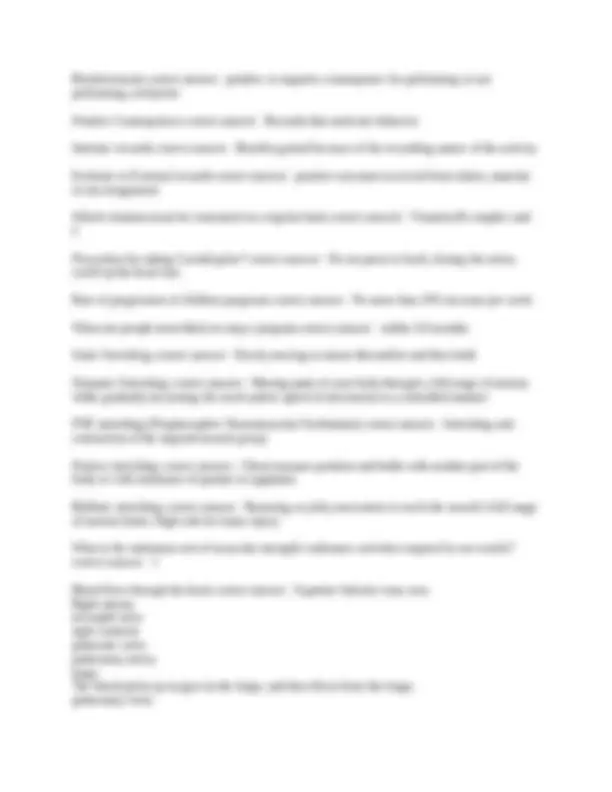
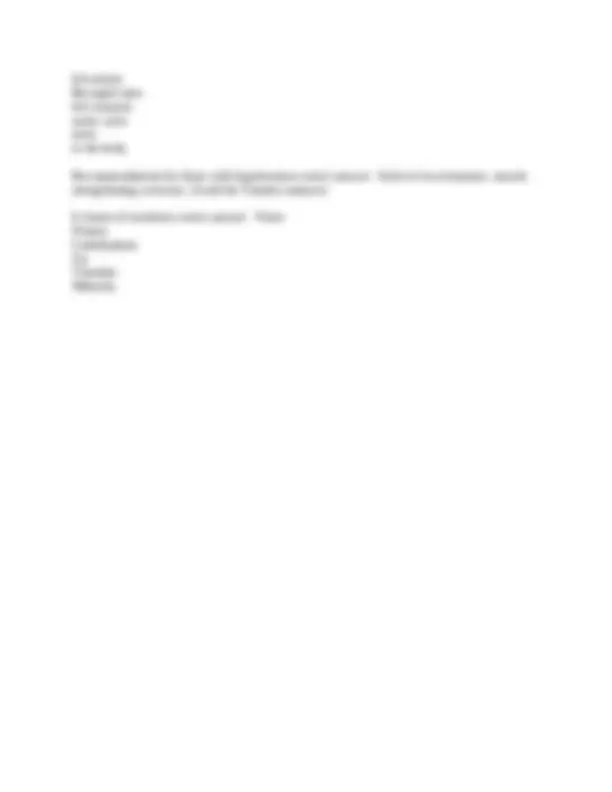


Study with the several resources on Docsity

Earn points by helping other students or get them with a premium plan


Prepare for your exams
Study with the several resources on Docsity

Earn points to download
Earn points by helping other students or get them with a premium plan
Community
Ask the community for help and clear up your study doubts
Discover the best universities in your country according to Docsity users
Free resources
Download our free guides on studying techniques, anxiety management strategies, and thesis advice from Docsity tutors
138 questions and answers related to various health and fitness components, primary activity recommendations, exercise definitions, risk factors for cardiovascular disease, anatomical planes, injury protocols, and fitness testing. It is intended for individuals preparing for the acsm certified personal trainer exam.
Typology: Exams
1 / 10

This page cannot be seen from the preview
Don't miss anything!







5 Health related fitness components correct answer: Cardiorespiratory endurance Body Composition Muscular Strength Muscular Endurance Flexibility ACSM-AHA Primary physical activity recommendations correct answer: minimum 3-5 days of 30-60min of moderate and vigorous exercise including minimum of 2 days muscular strength and endurance ACSM-AHA recommendations for moderate exercise correct answer: minimum 5 days/ week 30min/ day ACSM-AHA recommendations for vigorous exercise correct answer: minimum 3 days/ week 20/day Define Moderate Exercise correct answer: 40-60% vo2r; 3 - < 6 METS Define Vigorous Exercise correct answer: >/= to 60% vo2r; >/= 6 METS CVD RF for age correct answer: Men >/= 45 Women >/= 55 CVD RF for family history correct answer: Myocardial infarction, coronary revascularization, sudden death before age 55 (father) or 65 (mother) or 1st degree relative. CVD RF for cigarette smoking correct answer: Current or quit within last 6 months (or exposure environmentally) CVD RF for sedentary lifestyle correct answer: Not participating in minimum requirements of physical activity in last 3 months (30 min/ 3 days/ week) CVD RF for obesity correct answer: BMI >/= 30 or- Waist girth
102cm (Males) 88cm (Females) CVD RF for Hypertension correct answer: Systolic Blood Pressure >/= 140 OR Diastolic Blood Pressure >/= 90 OR Taking hypertensive medications (Tested on 2 separate occasions)
CVD RF for Dyslipidemia correct answer: Low Density Lypoprotiens (LDL) >/= 130 High Density Lypoproteins (HDL) < 40 CVD RF for prediabetes correct answer: Impaired Fasting Glucose >/= CVD Negative Risk Factor correct answer: HDL >/= Low Risk for CVD and Risk Stratification correct answer: Asymptomatic < 2 RF No Doctor recommendation needed for moderate or vigorous exercise/ Testing Moderate Risk for CVD and Risk Stratification correct answer: Asymptomatic
/= 2 RF Doctor recommendation needed for vigorous exercise High Risk for CVD and Risk Stratification correct answer: Symptomatic or Know CVD MD recommendation needed for Moderate and Vigorous exercise/ testing Anatomical Planes of the Body correct answer: Sagittal- Divides into Left/ Right (nose) Transverse- Divides into Superior/ Inferior Frontal- Divides Anterior/ Posterior RICE Protocol for acute injuries correct answer: Rest Ice Compression Elevation Trans-theoretical Model for Change (TTM) correct answer: Change is based on ones readiness to change PT should base process on clients current stage Pre-contemplation Contemplation Preparation Action Maintenance >6 months Health Belief Model (HBM) correct answer: Change is predicated on ones feeling of susceptibility to health consequences, the perceived seriousness, and the belief that making changes will reduce risk Theory of Planned Behavior (TPB) correct answer: Behavior changes result in health change Social Cognitive Theory (SCT) correct answer: Reinforcements, self-efficacy, coping skills, thoughts and feelings important for change
Approx. how many calories per lb of body weight? correct answer: 3, What is Basal Metabolic Rate? (BMR) correct answer: The amount of energy expended while at rest Formula to determine calories expended during a given activity? correct answer: (METs x 3.5 x BWkg) / 200 What does SMART stand for? correct answer: Specific Measurable Attainable Realistic Timely What is the order of Fitness testing? correct answer: Resting HR Resting BP Body Composition Cardiovascular Fitness Muscular Strength/ Endurance Flexibility What does FITT stand for/ correct answer: Frequency Intensity Time Type Hyperkyposis correct answer: Exaggerated posterior thorasic curve (hunch) Hyperlordosis correct answer: Exaggerated anterior lumbar curvature Scoliosis correct answer: Commonly found abnormal spine curve in frontal plane Calorie guidelines for Losing/ Gaining weight and how much per week? correct answer: +/- 500-1000 kcal per day 1-2 lbs per week Risky Waist to Hip Ratios correct answer: Men >. Women >. AOMS correct answer: Acute Onset Muscle Soreness pain and fatigue diminishes when exercise stops
DOMS correct answer: Delayed Onset Muscle Soreness Discomfort 24-36 hours after exercise Medial correct answer: Toward the midline of the body Lateral correct answer: Away from the midline of the body Ipsilateral correct answer: On the same side Contralateral correct answer: On the opposite side unilateral correct answer: One side Bilateral correct answer: Both sides Prone correct answer: Lying face down Supine correct answer: Lying face up Anterior correct answer: The front of the body; ventral Posterior correct answer: The back of the body; Dorsal Superficial correct answer: Located on or close to the body surface Deep correct answer: Below the surface Proximal correct answer: Closer to any reference point Distal correct answer: Farther from any reference point Superior correct answer: Toward the head; higher Inferior correct answer: Away from the head; lower Flexion correct answer: Decrease of the joint angle, usually moving anteriorly in the sagittal plane Extension correct answer: Increase of the joint angle, usually moving posteriorly in the sagittal plane Abduction correct answer: Movement away from the midline of the body
What are considered the good fats correct answer: Polyunsaturated fatty acids monounsaturated fatty acids Water-Soluble vitamins correct answer: C Thiamin Riboflavin Niacin Fat-Soluble vitamins correct answer: A D E K Level of Protein uptake per lb of BW? correct answer: 1.5g Precontemplation correct answer: Not intending to take action Contemplation correct answer: Considering changes withing next 6 months Preparation correct answer: Has developed a plan of action toward behavior changes. or irregular exerciser Action correct answer: Actively making behavior changes. Regularly active for < 6 Months. Greatest chance for relapse Maintenance correct answer: Maintaining changes and working to prevent relapse What does the informed consent form intended to ensure the client? correct answer: Has full knowledge of what tests are going to be performed Understands the relevant risks associated with those tests Knows about alternative procedures understands the benefits associated with the assesments Is provided with an opportunity for inquiry Gives consent voluntarily, not under any duress or fact inaccuracy Is of legal age and mentally competent 2 sites for testing HR correct answer: Radial Carotid How far should your fingers be away from skinfold calipers? correct answer: 1cm What calls for a re-test of a skinfold test? correct answer: difference in measurements is >/= 2mm What should a warmup portion of a session consist of? correct answer: 5-10 min of low to moderate intensity cardiorespiratory and muscular endurance activities
What should conditioning portion of a session consist of? correct answer: 20-60min of aerobic, resistance, neuromotor and/or sports activities What should a cooldown portion of a session consist of? correct answer: 5-10 min of low to moderate intensity cardiorespiratory and muscular endurance activities What should a Flexibility portion of a session consist of? correct answer: 10 min of stretching after the warmup or cooldown Reps for Stregth/ Power correct answer: 8- Reps for Improving Strength in Mid-Older Individuals correct answer: 10- Reps for muscular endurance correct answer: 15- SAID correct answer: Specific Adaptation to Imposed Demand SMART correct answer: Specific Measurable Attainable Realistic Timely How many cervical Vertebrae? correct answer: 7 How many thoracic Vertebrae? correct answer: 12 How many lumbar Vertebrae? correct answer: 5 What is a Triglyceride? correct answer: Glycerol molecule connected to three fatty acid molecules An adequate ROM in what muscle group helps elevate back pain? correct answer: Hamstrings negligence correct answer: a failure to conform to one's conduct to a generally accepted standard or duty. Omission correct answer: Failure to act Commission correct answer: Conscious voluntary act Body Composition correct answer: Refers to the relative proportion of fat and fat-free tissue in the body
left atrium Bicuspid valve left ventricle aortic valve aorta to the body Recommendations for those with hypertension correct answer: Stick to low-resistance, muscle strengthening exercises. Avoid the Valsalva manuver 6 classes of nutrients correct answer: Water Protein Carbohydrate Fat Vitamins Minerals